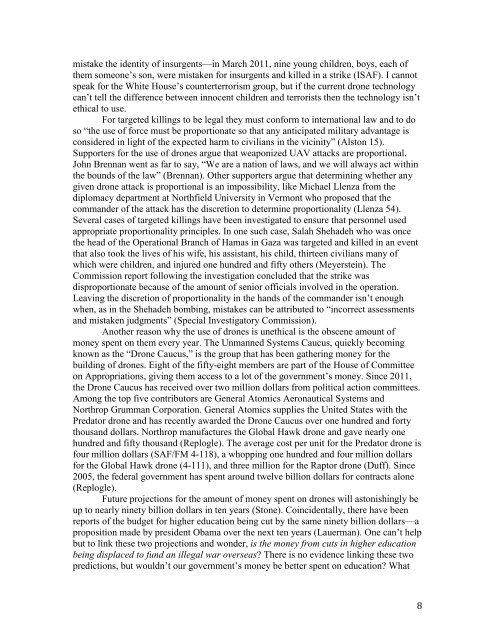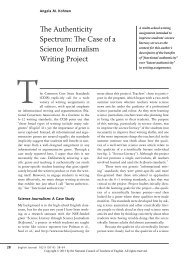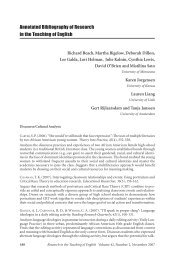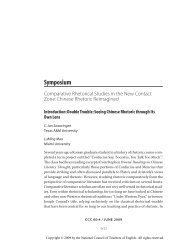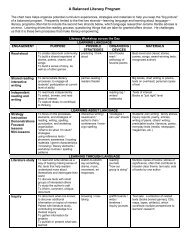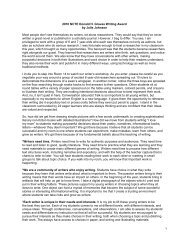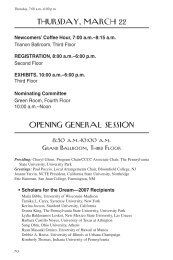1 Float Like a Plane, Sting Like a Bomb: The Ethics of US Drone ...
1 Float Like a Plane, Sting Like a Bomb: The Ethics of US Drone ...
1 Float Like a Plane, Sting Like a Bomb: The Ethics of US Drone ...
You also want an ePaper? Increase the reach of your titles
YUMPU automatically turns print PDFs into web optimized ePapers that Google loves.
mistake the identity <strong>of</strong> insurgents—in March 2011, nine young children, boys, each <strong>of</strong>them someone’s son, were mistaken for insurgents and killed in a strike (ISAF). I cannotspeak for the White House’s counterterrorism group, but if the current drone technologycan’t tell the difference between innocent children and terrorists then the technology isn’tethical to use.For targeted killings to be legal they must conform to international law and to doso “the use <strong>of</strong> force must be proportionate so that any anticipated military advantage isconsidered in light <strong>of</strong> the expected harm to civilians in the vicinity” (Alston 15).Supporters for the use <strong>of</strong> drones argue that weaponized UAV attacks are proportional.John Brennan went as far to say, “We are a nation <strong>of</strong> laws, and we will always act withinthe bounds <strong>of</strong> the law” (Brennan). Other supporters argue that determining whether anygiven drone attack is proportional is an impossibility, like Michael Llenza from thediplomacy department at Northfield University in Vermont who proposed that thecommander <strong>of</strong> the attack has the discretion to determine proportionality (Llenza 54).Several cases <strong>of</strong> targeted killings have been investigated to ensure that personnel usedappropriate proportionality principles. In one such case, Salah Shehadeh who was oncethe head <strong>of</strong> the Operational Branch <strong>of</strong> Hamas in Gaza was targeted and killed in an eventthat also took the lives <strong>of</strong> his wife, his assistant, his child, thirteen civilians many <strong>of</strong>which were children, and injured one hundred and fifty others (Meyerstein). <strong>The</strong>Commission report following the investigation concluded that the strike wasdisproportionate because <strong>of</strong> the amount <strong>of</strong> senior <strong>of</strong>ficials involved in the operation.Leaving the discretion <strong>of</strong> proportionality in the hands <strong>of</strong> the commander isn’t enoughwhen, as in the Shehadeh bombing, mistakes can be attributed to “incorrect assessmentsand mistaken judgments” (Special Investigatory Commission).Another reason why the use <strong>of</strong> drones is unethical is the obscene amount <strong>of</strong>money spent on them every year. <strong>The</strong> Unmanned Systems Caucus, quickly becomingknown as the “<strong>Drone</strong> Caucus,” is the group that has been gathering money for thebuilding <strong>of</strong> drones. Eight <strong>of</strong> the fifty-eight members are part <strong>of</strong> the House <strong>of</strong> Committeeon Appropriations, giving them access to a lot <strong>of</strong> the government’s money. Since 2011,the <strong>Drone</strong> Caucus has received over two million dollars from political action committees.Among the top five contributors are General Atomics Aeronautical Systems andNorthrop Grumman Corporation. General Atomics supplies the United States with thePredator drone and has recently awarded the <strong>Drone</strong> Caucus over one hundred and fortythousand dollars. Northrop manufactures the Global Hawk drone and gave nearly onehundred and fifty thousand (Replogle). <strong>The</strong> average cost per unit for the Predator drone isfour million dollars (SAF/FM 4-118), a whopping one hundred and four million dollarsfor the Global Hawk drone (4-111), and three million for the Raptor drone (Duff). Since2005, the federal government has spent around twelve billion dollars for contracts alone(Replogle).Future projections for the amount <strong>of</strong> money spent on drones will astonishingly beup to nearly ninety billion dollars in ten years (Stone). Coincidentally, there have beenreports <strong>of</strong> the budget for higher education being cut by the same ninety billion dollars—aproposition made by president Obama over the next ten years (Lauerman). One can’t helpbut to link these two projections and wonder, is the money from cuts in higher educationbeing displaced to fund an illegal war overseas? <strong>The</strong>re is no evidence linking these twopredictions, but wouldn’t our government’s money be better spent on education? What8


